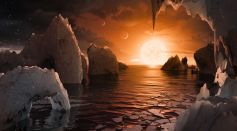Tags: Exoplanet
Experts Found Earth-Sized Rogue Planet Floating in Milky Way

Aliens From Almost 1,000 Nearby Stars Could Be Looking Straight Back at Us
"Superhabitable" Exoplanets May Be Better Than Earth

X-Ray Data Reveals First Planet Candidate From Another Galaxy
New Study Finds at Least 45 Planets With Qualities Similar to Earth

Other Stars Can Support Up To Seven Habitable Planets
4 Most Interesting Things Ever Found Across the Universe
Scientists: Two Newly Discovered ‘Super Earth’ Exoplanets Are Habitable
There Might Be ‘Ocean World’ Planets Within the Milky Way, Planetary Scientist Claims
Scientists Discover Hot Jupiters That Rain Titanium, and That's Not the Best Part of the Research Yet!
Rocky Earth-like Planet Found Orbiting A Star One-Tenth of The Sun's Size 25,000 Light Years Away
First Exoplanet Discovered by NASA’s Hubble Space Telescope Suddenly Disappeared, Where Could It Possibly Go?
Gigantic Exoplanet Might be the Exposed Core of a Giant Gas Planet
It's Raining Iron on a Distant Exoplanet

CHEOPS Launched by European Space Agency to Search for Exoplanets
NASA's TESS Finds its Smallest Exoplanet Yet
Astronomers Discover a “Forbidden Planet”
The Hottest Known Exoplanet Has Rare-Earth Metals
Planet Habitability Could Depend on Its Interior Composition Rather than Atmospheric Conditions
TESS Finds Earth-Sized Exoplanet 53 Light Years Away
Most Popular

Will Earth's Magnetic Poles Flip Next? Magnetic Pole Reversal Explained Through Cutting‑Edge Magnetosphere Science

Relativity Time Dilation Explained: The Physics of Time and Why It Moves Differently in Space

How Lightning Science Reveals Why Charged Storms Are Rising with Global Warming Effects

How AI Is Used in Weather Prediction: Smarter Forecasting Through Machine Learning




